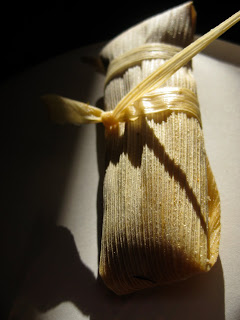As Felipe Fernandez-Armesto points out in his excellent Near a Thousand Tables (read it now!), gluttony has been an ideal until just this last century: fatties have been cultural heroes for millennia.
So we were in good company. Heroic company, at any rate.
As with all birthdays, holidays, and just plain old days, I do my best to break the dinner table with an overabundance of good food, and, Hana being a nice Southern girl, I of course had to go and make a good old Southern Sunday dinner: pulled pork shoulder and homemade barbecue sauce, cole slaw, potato salad, real macaroni and cheese, green chile corn bread, biscuits, and apple pie. All we were missing was bourbon and moonshine.
And as a nice Jewish boy from the outskirts of The City, I'm not exactly an old barbecue head, but there ain't nothing as easy or cheap as rubbed pork seared off on the stove and braised low and slow in beer in the oven. Five to seven hours at 350 will do the trick, the longer the better.

This type of cooking is almost entirely failsafe, and so I strongly recommend that you invent your own rub. Using recipes only as guidelines, mentally taste what you're aiming for: how will flavors work together, and what spices are appropriate?
If you're going to use sugar, which I strongly recommend, you may want to add a bit of vinegar to your braising liquid to counter the sweetness, and remember that brown sugar and molasses are more flavorful than white. If you use chipotle powder, which has a great smokey flavor, remember that it's very spicy before adding it to your rub, and that heat can tempered (moderately) by sugar and vinegar. Finally, your rub should be bolder and more powerfully flavored than may necessarily be palatable when you taste it on its own – sweeter, saltier, spicier, more bitter – because you want your flavors to really permeate the meat.
My rub, a total of about two cups, consisted of chipotle powder and mesquite, cumin, adobo (a mix of salt, onion powder and garlic powder), black pepper, and brown sugar.
I very, very generously rubbed it into a four pound shoulder, seared it on blazing hot cast iron, added a bottle of dark beer, a couple or two onions and a cup of orange juice (optional).
For the barbecue sauce, which I again recommend you invent, I brewed an insanely strong pot of coffee and dumped a cup or two into a sauce pan with the juice and zest of two oranges, two cups of ketchup, a quarter cup of vinegar, enough molasses to tame the acidity of the vinegar and the bitterness of the coffee, a whole head of garlic, cumin, salt, black pepper, and as much chipotle powder I could handle. After the pork finished, I added the braising liquid to the barbecue sauce and reduced to a nice sauce with a ketchup consistency. Bourbon, whiskey, or beer would be nice touches as well.
Because of the sheer volume of food, I'm going to hold off on posting recipes for the other items on the menu unless they're requested.








